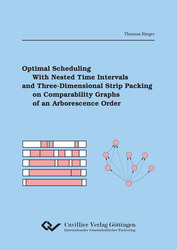| Areas | |
|---|---|
| Serie de libros (96) |
1378
|
| Nachhaltigkeit |
3
|
| Gesundheitswesen |
1
|
| Letra |
2364
|
| Ciencias Naturales |
5406
|
| Matemática | 229 |
| Informática | 319 |
| Física | 980 |
| Química | 1363 |
| Geociencias | 131 |
| Medicina humana | 243 |
| Estomatología | 10 |
| Veterinaria | 108 |
| Farmacia | 147 |
| Biología | 835 |
| Bioquímica, biología molecular, tecnología genética | 121 |
| Biofísica | 25 |
| Nutrición | 45 |
| Agricultura | 1004 |
| Silvicultura | 201 |
| Horticultura | 20 |
| Ecología y conservación de la tierra | 148 |
| Ciencias Ingeniería |
1793
|
| General |
98
|
|
Leitlinien Unfallchirurgie
5. Auflage bestellen |
|
Erweiterte Suche
Optimal Scheduling with Nested Time Intervals and Three-Dimensional Strip Packing on Compara-bility Graphs of an Arborescence Order (Tienda española)
Thomas Rieger (Autor)Previo
Indice, PDF (48 KB)
Lectura de prueba, PDF (110 KB)
This thesis is concerned with scheduling and three-dimensional packing problems that arise when restricting to nested intervals – either for allocating jobs to time intervals (at machines) or for positioning boxes within a strip. The scheduling problems considered in the first part of this work are motivated by a real-world application in rail car maintenance, and result in a new type of job characteristic introduced into the methodology of scheduling. Being classified as strip packing problems on comparability graphs of an arborescence order, the packing problems of the second part of this thesis are further structurally characterized based on the concept of packing classes. It turns out that using this characterization, these packing problems can equivalently be solved by interval coloring adequate chordal graphs. For several variants of above-mentioned mathematical optimization problems complexity results are derived and approximation, pure heuristical as well as exact solution approaches presented. The performance of the approaches is finally discussed based on computational results.
| ISBN-13 (Impresion) | 9783736990357 |
| ISBN-13 (E-Book) | 9783736980358 |
| Formato | A5 |
| Idioma | Inglés |
| Numero de paginas | 164 |
| Laminacion de la cubierta | Brillante |
| Edicion | 1. Aufl. |
| Lugar de publicacion | Göttingen |
| Lugar de la disertacion | Braunschweig |
| Fecha de publicacion | 13.07.2015 |
| Clasificacion simple | Tesis doctoral |
| Area |
Matemática
Matemática aplicada |
| Palabras claves | Scheduling, Strip Packing, Discrete Optimization, Mixed Integer Programming |








